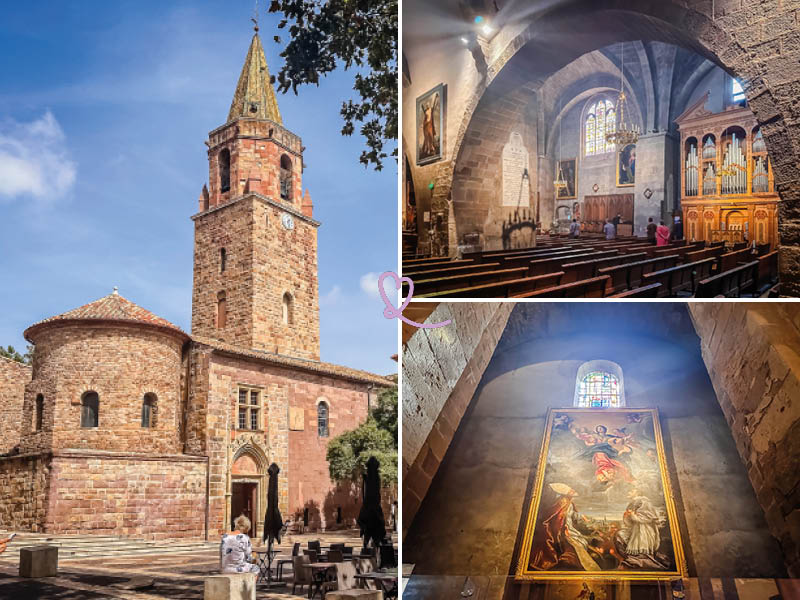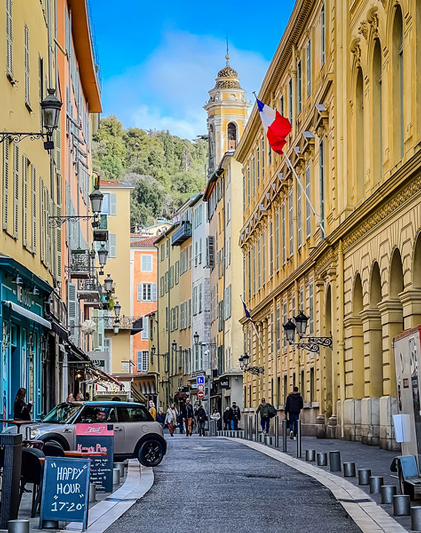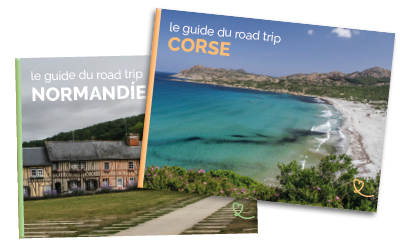If you’re planning a Côte d’Azur getaway, we invite you to make a detour and visit Fréjus’ Cathédrale Saint-Léonce. Its thousand-year history, marked by successive constructions and renovations, makes it a spiritual and cultural symbol of the region. Built on the ancient Roman city of Forum Julii, it blends Romanesque and Gothic styles in a captivating visual symphony of Provence colors.
In this article, you’ll find a selection of useful tips to help you prepare for your visit. We tell you more about this unique building listed as a Monument Historique!

This guide is completely independent, based on our experiences. We visited the region anonymously, making our own choices and paying our bills in full.
Why visit Fréjus Cathedral?
Is the cathedral worth it? Our opinion:
Yes, the Saint-Léonce Cathedral in Fréjus is well worth a visit for several reasons:
- Its fascinating history: dating back to Antiquity, this historic monument is a privileged witness to the evolution of the town of Fréjus through the ages. Its walls have taught us a great deal about the different periods that shaped its construction.
- Its astonishing, evolving architecture: the buildings are a surprising blend of Romanesque and Gothic styles. We were attentive to every detail, every architectural element. They all tell a story and bear witness to the skills of the craftsmen who helped build it.
- Its many artistic treasures: paintings, sculptures, stained glass and other precious liturgical objects offer a glimpse of the cultural and spiritual wealth of the area. They also offer a glimpse of religious life in the region through the ages.

The discreet charm of this medieval cathedral contrasts with the flamboyant neo-Byzantine style of the nearby Basilica of Our Lady of Victory in St. Raphael. We invite you to visit it too, for a better comparison of very different styles and atmospheres.
Why is St. Leonce Cathedral so famous?
Fréjus Cathedral is famous for its distinctive architecture. It is in fact a double cathedral, combining the 2 large naves of 2 different churches, built at different times. But it’s the baptistery that makes it so famous. Dating from the 5th century, it is one of the oldest in France. It’s a rare example ofearly Christian architecture. Its conservation makes it a focal point that we greatly appreciated during our visit.
The adjoining cloister is one of the main elements of the Fréjus cathedral group. Built in the 13th century, it is a remarkable testimony to the medieval history of Provence. Work was underway at the time of our visit, and we were unable to enjoy the 2-level galleries or the magnificent medieval painted ceilings. We could only catch a glimpse of it through the windows of the Musée archéologique de Fréjus overlooking the cloister.

Our favorite moments
We visited the cathedral in the late morning on a sunny day. The light was exceptional in this dark, contemplative setting.
- We loved its mineral atmosphere. Bare stones almost everywhere in the building, both inside and out, are made from polychrome sandstone from the Estérel region. It gives it the pinkish hue so characteristic of original Provencal buildings.
- The baptistery is a marvel! A rare symbol of early Christian art, it offers a fascinating insight into early Christian rites. It is the second oldest in France after Poitiers.
- The altarpiece of Saint Marguerite in the first chapel on the left in the nave of Saint-Étienne was awe-inspiring. It is attributed to a 15th-century painter from Nice, Jacopo Durandi. Saint Marguerite (Margaret of Antioch) protects pregnant women and those with kidney problems.

WHERE TO STAY IN Saint-Raphaël
Option 1 : downtown and beaches of Saint-Raphaël and Fréjus
Enjoy the charm of the towns and all the restaurants.
We recommend..:
- Hotel Unique – see prices, photos and availability
- Hotel Le Touring – prices, pictures and availability

Option 2: Along the coast to Esterel
By the sea, luxury hotels near the red rocks of the Esterel. We recommend..:
- Hotel La Villa Mauresque – prices, pictures and availability
- Hotel Les Roches Rouges – prices, pictures and availability

Option 3: in the countryside
For more peace and quiet, enjoy the sea or the countryside, but still close enough to the city. We recommend..:
- Hotel Le Confidentiel – prices, pictures and availability
- Hotel la Bastide du Clos des Roses – see prices, pictures and availability

History in brief
Fréjus Cathedral is dedicated to Saint-Léonce, who was the city’s bishop in the 5th century. Early Christian features are still visible, such as its famous baptistery, one of the oldest in France and also the best preserved. At the same time, a first building was erected where the main nave now stands.
It wasn’t until the 11th century that other canonical buildings gradually sprang up around the cathedral, including the cloister and the episcopal residence (today’s Hôtel de Ville), as well as the parish church, adjacent to the cathedral. This is Saint-Étienne church. The joining of the two naves, Notre-Dame and Saint-Étienne, dates back to the 14th century.

At the same time, the town of Fréjus fortified itself. The episcopal group, too, is protected by a thick, embossed wall, completed by a high, crenellated tower with machicolations. Over the years, further improvements were made, integrating Gothic elements into this medieval building, such as the openings on the south side.
Fréjus Cathedral has been a listed historic monument since 1862. Find out more here.

How to get there: Saint-Léonce Cathedral, Fréjus
Where is the cathedral?
Fréjus Cathedral is located on Place Camille Formigé, in the center of Fréjus (83600).
It’s located on the heights of the city, right next to the Town Hall and just a few minutes’ walk from the Tourist Office.
OUR TPS FOR RENTING YOUR CAR IN Provence
- Compare prices on our preferred platform: DiscoverCars – one of the best rated sites.
- Choose a car that is powerful enough (the roads are steep) but compact (some passages are narrow).
- Think of thecomplete insurance (some roads are tortuous and narrow).
- There is a lot of demand, book it early.

How to get there?
You have several options for getting to St. Leonce’s Cathedral:
- By car: the site is well signposted and easy to get to, but traffic can be heavy (especially in summer) and/or impeded (on market days: Wednesday and Saturday mornings).
- By bike: two-wheel parking is available 50m from the monument.
- By bus: from Fréjus bus station, take a 5-minute walk.
- By train: from Fréjus SNCF station, 7-minute walk.

Parking
There are plenty of parking lots in Fréjus. The nearest to the cathedral is Parking Paul Vernet. During our visit, we left our car a little further down the road at the Clos de la Tour parking lot, near the bus station.
The first 1/2 hour is free in both parking lots. Find out more here.

PLAN YOUR STAY IN Saint-Raphaël

Useful tips: duration, schedules, eating…
Best time to visit
The cathedral can be visited at any time of day. Its freshness is particularly pleasant in the hottest hours. Nevertheless, visiting in the morning is a guarantee of tranquillity. In any case, it’s best to avoid church hours.
The cathedral is also a venue for exceptional organ recitals. The Association des Amis de la Cathédrale de Fréjus organizes numerous concerts throughout the year. See the program here.

Length of visit and main difficulties
Allow between 15 and 45 minutes to visit the cathedral.
15 to 45min also for the cloister if you wish to enrich your visit.
Once through the entrance gates, it’s down a flight of steps to the cathedral’s airlock. It is therefore not accessible to people with reduced mobility. Just like the baptistery.
For visits to the cloister, however, adapted aids are available for disabled visitors. Find out more here.

Advice on how to visit
Once inside the cathedral, we first entered the baptistery on our left, before passing under the narthex (a sort of vestibule) on the right, which gives access to the nave of Notre-Dame.
From there, we headed up the St. Stephen’s nave on our left to admire the works on the north side of the building. We returned to the exit via the Notre-Dame nave, where a monumental organ in the Italian tradition is enthroned.

A LITTLE MORE patience
All the photos, maps, information, good addresses to make your stay in Provence a success, will soon be gathered in a single ebook!
If you wish to be informed of the publication of our guide on Provence, subscribe:

Schedules and rates
Entrance to and tours of the cathedral are free of charge.
The cathedral is open all year round at the following times:
- Sunday and Monday: 8:30 a.m. – 6:30 p.m.
- Tuesday, Wednesday, Thursday, Friday, Saturday: 8.30am – 7pm
The cloister is open:
- April 28 to August 31: 10 a.m. to 6 p.m.
- September 1 to April 27: 10 a.m. – 1 p.m. and 2 p.m. – 5 p.m.
The cloister is closed on Mondays.
Price: €7
See here for free conditions.
You can book your ticket today here.

Guided tours
There is no guided tour of the cathedral. But they are also available for exploring the cloister. They last 45 minutes, at no extra cost to you. Simply register at reception on arrival. Tour documents are also available in 7 languages.
Nearby restaurants
There are plenty of restaurants in the center of Fréjus, but we decided to eat at the port, about a 30-minute walk away, to whet our appetites.
Gaëlle’s Creperie offers continuous service. We enjoyed a galette on the terrace by the water, with a breathtaking view of the sailboats.
Our article on where to eat in Fréjus and Saint-Raphaël will be available soon.

Start of visit: the exterior of the Episcopal city of Fréjus
The first thing that caught our eye above the pink mass of the building’s facades was the campanile-like bell tower rising up in the middle.
Colorful facades and multi-storey bell tower
We loved the mineral atmosphere of the facades of Fréjus Cathedral. Its rough, pinkish stonework contrasts with the ochre rendering of the Hôtel de Ville (former episcopal residence). The ensemble is decorated in the typical colors of Provencal buildings, with a hint of Italian influence.

The bell tower dates back to the 13th century. The golden reflections of its conical roof enchanted us. They are the result of a mosaic of yellow and green tiles. It rests on a 16th-century octagonal frame, which in turn rests on an earlier square base. The bell tower houses 4 bells. One of them was named Saint-Léonce. It was donated by Pope John XXIII in 1303.

The Gothic portal
The Romanesque openings of the baptistery and bell tower coexist with the Gothic style of the cathedral’s entrance portal. It was pierced during the Renaissance. We were particularly interested in the scuptured details of its lintel. Dated April 1, 1530, it is believed to be the work of Nice artist Jacopo Durandi. It is topped by splendid cross-headed windows.

To the right of the entrance portal, the sundial caught our eye. It dates from 1781 and bears a Latin inscription in gilded letters which reads: “Shadow and light regulate the offices of the clergy, the work of Themis (justice) and Mars (arms), and the assemblies of the elders”.

Continuation of the tour: the airlock
The entrance portal opens onto a flight of steps leading down to what might be considered a vestibule. To the left, the baptistery; to the right, the narthex; and opposite, an entrance to the cloister, which was closed at the time of our visit.
The early Christian baptistery
This is one of our favorite moments of the visit. The Fréjus baptistery is one of the oldest in France. It’s an octagonal room punctuated by antique columns. They probably come from a Roman building and support its cupola.

In the center, the vat was used for baptism by immersion, as originally practiced. Those wishing to receive the sacrament (catechumens) entered through a small, low door to the left of the present-day entrance. Once baptized, they exited through a larger door on the right, and had access to the cathedral’s sacred space.

The narthex between profane and sacred
The narthex is an interior portico found at the entrance to some medieval churches. It’s also an intermediary space between the outside (the profane) and the inside (the sacred). The one in Fréjus cathedral struck us as particularly solemn. It immerses visitors in an atmosphere of peace and contemplation.

It is framed by four gigantic pillars that support the weight of the bell tower. Here you can see the markings of the stonemasons who marked the blocks to earn their pay by the piece. The narhex also offers remakable paintings such as The Donation of the Rosary, an 18th-century work.

Once past the narthex, visitors finally enter the cathedral’s double nave, first that of Notre-Dame Church, then, on the left, that of St. Stephen’s Church. We began our tour with the latter, before returning to the Notre-Dame nave.

Under the 6 barrel vaults of St. Stephen’s Church
Among all the treasures to be found in the nave of Saint-Étienne, we really enjoyed the story told by the carved stone in the tomb of Barthélémy and Pierre Camelin. It dates from the 18th century. Both were bishops of Fréjus. They came from a family of Italian merchants established in Fréjus at the dawn of the 16th century.

Right next to their tomb, the Baroque altarpiece painting of the imploration shows Saint Félix, Saint Léonce and Saint Etienne imploring the Holy Trinity for the town of Fréjus.

We then passed the famous altarpiece of St. Margaret, one of our favorite moments of the visit. It is attributed to 15th-century Nice artist Jacopo Durandi. Marguerite d’Antioche (since this is who we’re talking about) brings protection to pregnant women and those suffering from kidney problems.

At the far end of the nave of Saint-Étienne, we lingered in the intimate space of the Chapelle du Saint Sacrement. We liked its contemporary stained glass windows, which contrast with the baroque spirit of the altar.

Under the 3 pointed arches of Notre-Dame Church
We then moved on to the Notre-Dame nave. Thesemi-circular vaulted apse, in the so-called “cul-de-four” style, is clad in wood and decorated with stalls. The altar is of recent manufacture. It is made of green-hued Serpentine stone and bronze.

The most spectacular feature of this Romanesque nave is undoubtedly the magnificent organ enthroned in its center. It is of recent manufacture. Inaugurated in 1991, it is the work of Pascal Quoirin, the organ builder involved in the restoration of the Great Organ of Notre-Dame-de-Paris, which was spared the fire of 2019. Find out more here.

The Fréjus organ deliberately refers to the Italian style, reviving the regional tradition of this part of south-east France long influenced by Italy.
The shape of the organ case and its trompe l’oeil carving and marquetry are freely inspired by Italian organs of the 17th and 18th centuries.

Heading for the exit, we admired Camillo Saturno’s Holy Family. Saturno was a painter of Roman origin. He was active in Provence from 1561 to 1576, working mainly for the Archbishop of Aix-en-Provence. The painting was listed as a historic monument in 1907. Find out more here.

PLAN YOUR TRIP TO THE Côte d’Azur
- Inspiration
The most beautiful landscapes in 30 photos
Best things to do on the Côte d’Azur
Most beautiful villages
Best beaches on the Côte d’Azur
Most beautiful gardens
Best boat tours (coming soon)
Most beautiful islands
Secret places

- Practical advice
Successful travel on the Côte d’Azur (coming soon)
Rent a car in Provence – in Nice – in Cannes – in Marseille – in Aix-en-Provence.
Itineraries: 5 days – 1 week – 10 days
Weekend ideas: best-of – romantic – luxury – unusual

- Where to stay
Where to stay on the Côte d’Azur
Best luxury hotels on the Côte d’Azur
Hotels by the sea
Best boutique-hotels





